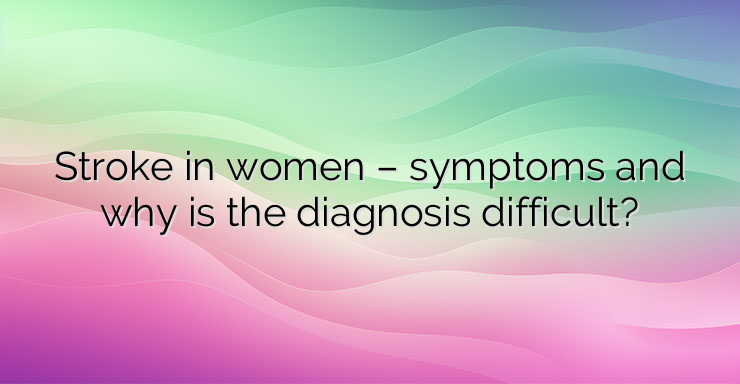In a stroke, every minute counts. The longer it takes to restore blood supply to the brain, the greater the risk of complications. That’s why it’s vital to act quickly, and that’s why it’s key to recognize the symptoms promptly. However, in women, stroke is more difficult to diagnose. Although classic symptoms such as movement and speech disturbance are seen, women also present with more general symptoms such as confusion and weakness, which can lead to delayed or misdiagnosis. That suggests a study by the George Institute for Global Health in Sydney, Australia. Risk of stroke Stroke occurs when there is a sudden loss of blood supply to a localized area of the brain and is the second leading cause of disability worldwide. Women are known to experience more complications after a stroke. Strokes in women occur at an older age than in men, so their health often deteriorates due to aging. However, strokes also occur in young women, and according to a University of Colorado study, women under the age of 35 are 44% more likely to develop a stroke than men of the same age. The reasons are mainly three: hormonal contraceptives, pregnancy and childbirth. The most commonly used contraceptives combine estrogens and progestogens and have a prothrombotic effect – they favor the aggregation of platelets and therefore the formation of blood clots. Both during pregnancy and after childbirth, the risk of deep vein thrombosis of the legs increases. Today, effective approaches and treatments have been developed to successfully manage stroke, but these approaches only give good results if applied during the hours after the stroke occurs, so early diagnosis is key. However, several studies have shown that women are more difficult to diagnose and this is associated with delays that lead to poorer treatment outcomes and more sequelae. Characteristic symptoms Clear warning signs of a stroke are sudden changes in balance or vision, drooping of the lower half of the face, twisting of the lips, sudden weakness on one side of the body, difficulty speaking or pronouncing the right words. These are characteristic symptoms that occur when a very specific area of the brain is deprived of blood supply. The problem is that there are other symptoms that are not very specific, and they are more common in women, which makes the diagnosis difficult. To identify the hallmark signs of stroke in women so that they are not overlooked, the team of researchers examined data from a total of 21 studies conducted between 2002 and 2020, collecting cases of 36,636 people who had suffered a stroke from of which between 45% and 55% are women. Studying the cases, the researchers found that women exhibited some symptoms more often than men,which are more non-specific and not related to the involvement of a specific area in the brain. In women, more frequent manifestations are: Confusion; Fatigue; Weakness; Headache; Loss of consciousness and changes in mental status. In women, the following symptoms occur less often: Difficulty speaking; Unsteadiness when walking; Changes in gait and balance. References: https://www.sabervivirtv.com/neurologia/sintomas-ictus-confusos-mujeres-detecta-tarde_7087 https://journals.sagepub.com/doi/10.1177/17474930221090133


Leave a Reply